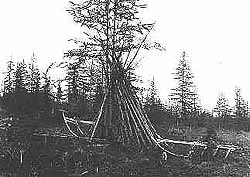Nganasans
Nganasans, the most northern Samoyed people, are living on the Taimyr Peninsula. They are always been a small people in number - 876 according to the census of 1897, 867 in 1979 and 1278 in 1989. They have not their own literary language.
Although the Nganasans had to pay fur tax to Moscow
from
1630s, they remained relatively isolated and retained archaic forms of
economy and technology, social relations and religion. Their main sources
of the livelihood were wild reindeer hunting and fishing. In early times the
Nganasans kept only a few reindeer, and not until the middle of the 19th
century did
they go in for reindeer breeding to any notable extent. They were nomads
who wandered with the annual reindeer migrations from the forest border to
tundra.
The Nganasans retained features of the patriarchal clan structure, but they were so few in number and inhabited such a large area that the clan had no territorial or economic unity. The Nganasan nomadic settlements were made up of families not necessarily belonging to the same clan. They were linked more by neighbourly relationships. A. Popov has written: "The social makeup of these settlements varied. Sometimes they consisted of groups of working households collaborating in hunting, fishing and pasturing reindeer. But more often they were poor households grouped around a rich reindeer-breeder and economically dependent on him."
One can speak about the remarkable influence of the Soviet power upon the Nganasans since the end of 1940's, when the local authorities undertook the liquidation of shamanism in Taimyr. Shaman drums and costumes were taken from the shamans and destroyed. Several of the shamans were sentenced because of their shaman activities. In 1960s the nomadic lifestyle of the Nganasans was put an end. The Nganasans were settled to the villages, where they are living together with Russians and Dolgans. Sudden changes in the lifestyle caused increase of many diseases and alcoholism. People in such villages depend fully on supply of the state, but many of them have only seasonal work.


Nganasan burial places
in the tundra near Ust-Avam village. Photos (30K and 78K) by A. Lintrop
1977.
More photos about Nganasans in the electronical
journal Folklore (vol.
1) - the photocommentary
Disappearing Nganasan Shamanism
Back to the Incantator
Back to the Shamans from Kosterkin Family page